战略选择论的起源、发展与复杂性范式
外国经济与管理 2006 年 第 28 卷第 01 期, 页码:9 - 16
摘要
参考文献
摘要
本文从战略选择的视角探讨了组织设计的理论难点问题。文章总结了战略选择理论的起源和发展过程,认为战略选择是一个与组织效能有关的问题,并非所有的组织内部行动者都能够对组织及其运作模式的选择做出相同的判断。本文还指出,战略选择是在组织内外环境不稳定条件下进行的,应当把组织的战略选择问题视为复杂系统来研究,并且致力于自然选择与战略选择的结合。
[1]Alfred D Chandler,Jr.Strategy and structure:chapters in the history of the american industrial enterprise[M].Cam-bridge,Massachusetts:MIT Press,1962.
[2]Alfred D Chandler,Jr.Corporate strategy and organization framework[M].New York:Harper Press,1965.
[3]Thomas H Hammond.Structure,strategy,and the agenda of the firm[A].In Richard P Rumelt,Dan E Schendel,andDavid J Teece,eds.Fundamental issues in strategy[C].Boston,Massachusetts:Harvard Business School Press,1994:97-154.
[4]John Child.Organization structure,environment and performance:the role of strategic choice[J].Sociology,1972,6(1):1-22.
[5]Karl E Weick.Enactment process in organizations[A].In Barry M Staw and Gerald R Salanick,eds.New directions inorganizational behavior(Chapter 8)[C].Chicago,Illinois:St.Clair Press,1977.
[6]William H Starbuck.Organization and their environment[A].In Marvin D Dunnette,ed.Handbook of industrial organi-zational psychology[C].Chicago Illinois:Rand McNally,1976:1069-1123;另参见:Arthur G Bedian&Raymond FZammuto.Organizations:theory and design[M].Chicago,Illinois:The Dryden Press,1991.
[7]Hiroyuki Itami and Thomas W.Roehl.Mobilizing invisible assets[M].Boston,Massachusetts:Harvard BusinessSchool Press,1987:Cha.2.
[8]Donald A Palmer,Roger Friedland,P Devereaux Jennings,and Melanie Powers.The economics and politics of struc-ture:the multidivisional form and the large US corporation[J].Administrative Science Quarterly,1987,32(1):25-48.
[9]Peter Cappelli,Laurie Bassi,Harry Katz,David Knoke,Paul Osterman and Michael Useem.Change at work:trendsthat are transforming the business of business[M].New York:Oxford University Press,1997.
[10]Marshall W Meyer.The weberian tradition in organizational research[A].In Craig Calhoun,Marshall W Meyer,andW Richard Scott,eds.Structures of power and constraint:papers in honor Peter M Blau[C].New York:Cambridge U-niversity Press,1990:191~215.
[11]Ralph D Stacey.The chaos frontier:creative strategic control for business[M].Oxford,London:Butterworth-Heine-mann,1991:10-11,19.
[12]Hugh Courtney.Foresight:crafting strategy in an uncertain world[M].Boston,Massachusetts:Harvard BusinessSchool Press,2001.
[13]Karl E Weick.Educational organizations as loosely coupled systems[J].Administrative Science Quarterly,1976,21(1):1-19.
[14]David J Hickson,Richard J Butler,David Cray,Geoffrey R Mallory,and David C Wilson.Top decisions:strategic de-cision making in organizations[M].San Francisco,California:Jossey Bass,1987.
[15]Lex Donaldson.American anti-management theories of organization:a critique of paradigm proliferation[M].Cam-bridge:Cambridge University Press,1995.
[16]Eric Bonabeau&Christopher Meyer.Swarm intelligence:a whole new way to think about business[J].Harvard Busi-ness Review,2001,79(5):107-114.
[17]Ralph D Stacey.Strategy as order emerging from chaos[J].Long Range Planning,1993,26(1):10-17.
[18]Manfred M Fischer and Josef Frohlich.Knowledge,complexity and innovation systems[M].Berlin:Springer Verlag,2001:1-17.
[19]David Levy.Chaos theory and strategy:theory application and managerial implications[J].Strategic Management Jour-nal,1994,15(SI):167-178.
[20]Daniel A Levinthal.Adaptation on rugged landscapes[J].Management Science,1997,43(7):934-950.
[21]Giovanni M Gavetti and Daniel A Levinthal.Looking forward and looking backward:cognitive and experiential search[J].Administrative Science Quarterly,2000,45(1):113-137.
[22]Jan W Rivkin.Imitation of complex strategies[J].Management Science,2000,46(6):824-844.
[23]Pankaj Ghemawat,David J Collis,Gary P Pisano and Jan W Rivkin.Strategy and the business landscape:core concepts[M].Englewood Cliffs,New Jersey:Prentice Hall,2001.
[24]Koen Frenken.Fitness landscapes,heuristics and technological paradigms:a critique on random search models in evolu-tionary economics[A].In Daniel M Dubois(ed.).Computing anticipatory systems[C].New York:Woodbury,2001.
[2]Alfred D Chandler,Jr.Corporate strategy and organization framework[M].New York:Harper Press,1965.
[3]Thomas H Hammond.Structure,strategy,and the agenda of the firm[A].In Richard P Rumelt,Dan E Schendel,andDavid J Teece,eds.Fundamental issues in strategy[C].Boston,Massachusetts:Harvard Business School Press,1994:97-154.
[4]John Child.Organization structure,environment and performance:the role of strategic choice[J].Sociology,1972,6(1):1-22.
[5]Karl E Weick.Enactment process in organizations[A].In Barry M Staw and Gerald R Salanick,eds.New directions inorganizational behavior(Chapter 8)[C].Chicago,Illinois:St.Clair Press,1977.
[6]William H Starbuck.Organization and their environment[A].In Marvin D Dunnette,ed.Handbook of industrial organi-zational psychology[C].Chicago Illinois:Rand McNally,1976:1069-1123;另参见:Arthur G Bedian&Raymond FZammuto.Organizations:theory and design[M].Chicago,Illinois:The Dryden Press,1991.
[7]Hiroyuki Itami and Thomas W.Roehl.Mobilizing invisible assets[M].Boston,Massachusetts:Harvard BusinessSchool Press,1987:Cha.2.
[8]Donald A Palmer,Roger Friedland,P Devereaux Jennings,and Melanie Powers.The economics and politics of struc-ture:the multidivisional form and the large US corporation[J].Administrative Science Quarterly,1987,32(1):25-48.
[9]Peter Cappelli,Laurie Bassi,Harry Katz,David Knoke,Paul Osterman and Michael Useem.Change at work:trendsthat are transforming the business of business[M].New York:Oxford University Press,1997.
[10]Marshall W Meyer.The weberian tradition in organizational research[A].In Craig Calhoun,Marshall W Meyer,andW Richard Scott,eds.Structures of power and constraint:papers in honor Peter M Blau[C].New York:Cambridge U-niversity Press,1990:191~215.
[11]Ralph D Stacey.The chaos frontier:creative strategic control for business[M].Oxford,London:Butterworth-Heine-mann,1991:10-11,19.
[12]Hugh Courtney.Foresight:crafting strategy in an uncertain world[M].Boston,Massachusetts:Harvard BusinessSchool Press,2001.
[13]Karl E Weick.Educational organizations as loosely coupled systems[J].Administrative Science Quarterly,1976,21(1):1-19.
[14]David J Hickson,Richard J Butler,David Cray,Geoffrey R Mallory,and David C Wilson.Top decisions:strategic de-cision making in organizations[M].San Francisco,California:Jossey Bass,1987.
[15]Lex Donaldson.American anti-management theories of organization:a critique of paradigm proliferation[M].Cam-bridge:Cambridge University Press,1995.
[16]Eric Bonabeau&Christopher Meyer.Swarm intelligence:a whole new way to think about business[J].Harvard Busi-ness Review,2001,79(5):107-114.
[17]Ralph D Stacey.Strategy as order emerging from chaos[J].Long Range Planning,1993,26(1):10-17.
[18]Manfred M Fischer and Josef Frohlich.Knowledge,complexity and innovation systems[M].Berlin:Springer Verlag,2001:1-17.
[19]David Levy.Chaos theory and strategy:theory application and managerial implications[J].Strategic Management Jour-nal,1994,15(SI):167-178.
[20]Daniel A Levinthal.Adaptation on rugged landscapes[J].Management Science,1997,43(7):934-950.
[21]Giovanni M Gavetti and Daniel A Levinthal.Looking forward and looking backward:cognitive and experiential search[J].Administrative Science Quarterly,2000,45(1):113-137.
[22]Jan W Rivkin.Imitation of complex strategies[J].Management Science,2000,46(6):824-844.
[23]Pankaj Ghemawat,David J Collis,Gary P Pisano and Jan W Rivkin.Strategy and the business landscape:core concepts[M].Englewood Cliffs,New Jersey:Prentice Hall,2001.
[24]Koen Frenken.Fitness landscapes,heuristics and technological paradigms:a critique on random search models in evolu-tionary economics[A].In Daniel M Dubois(ed.).Computing anticipatory systems[C].New York:Woodbury,2001.
引用本文
罗珉. 战略选择论的起源、发展与复杂性范式[J]. 外国经济与管理, 2006, 28(1): 9–16.
导出参考文献,格式为:
上一篇:双元型组织研究评介
下一篇:美、德、日劳资关系管理比较研究





 5618
5618  0
0

